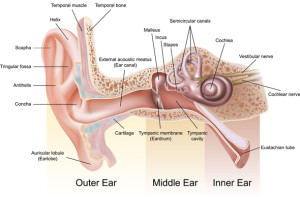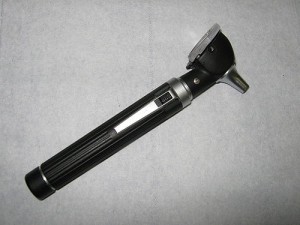1. What is a Middle Ear Infection?
Middle ear is the small air filled space behind the eardrum that contains tiny bones which help in conduction of sound. It can be infected with either bacteria or virus which causes swelling and fluid build up inside this space. This in turn cause increase in pressure inside the middle ear, leading to bulging of eardrum and pain.
2. How does my child gets Ear Infection?
Fig: Anatomy of the Human ear.
Human ear has three divisions outer, middle and inner ear. There is a small tube that connects the ear and the throat called Eustachian tube (See the picture). This tube helps to maintain the pressure inside the middle ear from building up, by letting the air move in and out. When the kids get cold, their throat can swell and this cause the tube to get blocked. When this tube gets blocked, it can trap fluid inside the middle ear and it makes it a perfect place for bacteria or virus to grow and cause infection.
In kids (<3yrs) this tube is very small and they can get blocked very easily. As the kids grow the Eustachian tube gets longer and would work better.
3. What are the symptoms?
The symptoms of ear infection usually come on suddenly. The symptoms of ear infection include:
- Ear pain and discomfort (Young babies might pull at their ears)
- Fever
- Irritable and difficulty sleeping
- Difficulty hearing
- Vomiting
- Fluid from the ear
- Headache.
4. When to see a doctor?
Though most ear infections clear up on their own, some times severe cases (especially in young babies) might require antibiotics and medication for fever and pain. Take your child to a doctor if there is one of the following
- If the symptoms last for more than a day
- If the child is irritable or in pain
- If you notice any discharge from ear.
5. How is middle ear infection diagnosed?
Your child’s doctor will diagnose middle ear infection from the child’s symptoms and by looking into the child’s ears using an instrument called otoscope (see the pictures). Always insist your doctor to examine the child’s ears, if you suspect your child might have an ear infection.
6. What is the treatment?
Treatment of an ear infection includes the following
Antibiotics: Most ear infections go away on their own. The use of antibiotics to treat the ear infection depends on your child’s age and how bad the infection is.
Wait and see approach: This can be done in the following conditions
- If the child is between 6 months – 2 years and with mild symptoms AND an uncertain diagnosis
- If the child is more than 2 years and with mild symptoms OR an uncertain diagnosis
Medications to relive pain and fever: Pain relieving medicines like ibuprofen or acetaminophen or ear drops which contain numbing medicine (antipyrine-benzocaine ear drops) can be used to reduce the pain.
Do not use COUGH OR COLD MEDICNES as they are not useful in helping your child’s ear infection and can have side effects.
If your doctor prescribe an antibiotic, it is VERY IMPORTANT to give the child, medicine for as many days as the doctor instructs, even if your child becomes better.
7. What to do if my child get repeated ear infections?
If your child gets repeated ear infections (More than 3 ear infections in 6 months or 4 ear infections in 1 year) then your child’s doctor might refer you to a ENT specialist for pacing a tube in your child’s eardrum (Tympanostomy tube).
9. How can ear infections be prevented?
- Vaccines: There are two vaccines that are currently that can help prevent ear infections. You can read more about these vaccines in the vaccine section on this website.
- Pneumococcal vaccine
- Haemophilus influenza vaccine
- Exposure to Smoke: Avoid places where people are smoking. Cigarette smoke.
- Hand washing: Proper hand washing regularly helps transmission of germs.
- Breastfeeding: Breastfeeding has shown to reduce ear infections significantly.


